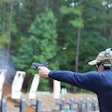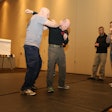Back in the day-and in suburbia, that means the late 1970s-Rio Rancho, N.M., was a sleepy Sunbelt town outside Albuquerque that catered to Midwest retirees with homespun names like Flo, Mabel, and Irv. Today, having eclipsed its retirement-community roots, Rio Rancho is a sprawling, master-planned boomtown and home to offices of high-tech corporations, including Sprint, Gateway, and Intel.
Growing along with the city has been the Rio Rancho Department of Public Safety (RRDPS). In less than two decades, the city-with a growing population of nearly 70,000 residents-has watched as the public-safety agency experienced a staggering 455-percent increase in personnel resources.
When Deputy Chief Steven L. Shaw started with the RRDPS in 1986, he was one of 20 officers, all of whom were then also cross-trained as firefighters and EMTs. The department now fields 111 police officers, who can specialize in a variety of assignments, including gang enforcement, crisis negotiation, K-9 handling, SWAT, or motorcycle-mounted traffic enforcement.
In 2001, the agency split from a fully integrated department of public safety to an administrative DPS. It fields three divisions: police, fire/rescue/EMS, and support services like code enforcement and animal control.
"When I moved here, we had two traffic lights, and the widest roadway was two lanes," Shaw says. "Since then, we've got eight [traffic] lanes in one stretch. ...And of course, I've since lost count of the number of traffic signals."
Located just 15 miles north of Albuquerque (and 50 miles south of Santa Fe), Rio Rancho is now the state's fourth-largest city. Detractors criticize its breakneck growth and cookie-cutter neighborhoods. Proponents say Rio Rancho offers benefits the larger cities can't: Lower crime rates, better schools (including a state-of-the-art high school once hailed by Time Magazine), and dramatically lower housing costs.
New houses in Rio Rancho sell for a fraction of what they cost in Santa Fe or even Albuquerque. In 2004, the average price for a home in Rio Rancho was $135,800. In Santa Fe, it was $388,000.
Also fueling Rio Rancho's popularity among the law-enforcement set are area police agencies' expanded take-home policies, which allow officers to drive patrol cars home-and thus, save on gas-if they live within a certain geographic distance. In Rio Rancho, it's not unusual for marked units to share driveway space alongside personal vehicles.
Rio Rancho's decision to increase salary and benefits to compete with surrounding agencies' offerings has made the municipal agency "attractive to the same applicant pool," Shaw says. Last summer when the department advertised three open positions, more than 50 people-most with previous law-enforcement experience-applied.
"We don't have a lot of street crime because we don't have an official downtown," says Officer John Francis, an 18-year veteran of the RRDPS. "We've been known as the city with the second-lowest per-capita crime rate in the state."
Part of Rio Rancho's reputation as a safe city may also have to do with the agency's high public profile. Cruise along just about any main thoroughfare, and you're likely to fall under the watchful gaze of at least one motor officer or parked patrol unit.
"We're very proactive in traffic enforcement," Shaw says. "There's an old adage that if you take care of the small things, the big things will take care of themselves. By being proactive in traffic enforcement, you are very visible. They see the patrol cars out there; they see the motorcycles out there, [and the general impression is] 'There's a whole lot of police around here.'"
Officers in Rio Rancho deal with the same bread-and-butter issues any rapidly growing community faces, including domestic violence, narcotics activity, and construction-site thievery. The city is large enough, however, to also challenge officers with the unexpected.
One of the most recent memorable calls involved a 15-year-old juvenile with a gun, allegedly en route to a local high school to settle a score with a rival. When police tried to stop him, he sped off in a vehicle. When a high-speed chase ended on the edge of a cliff, department crisis negotiators talked him into surrendering without further incident.
"It takes everyone working together," Shaw says of the city's historically low crime rate. "We have real close ties with our business communities, schools, neighborhood associations.
"It's nothing we've done on our own," he adds. "We just happen to be the ones who police the community."
Bryn Bailer, a former newspaper reporter, is a contributing editor for Police. By day, she is a member of the Tucson (Ariz.) Police Department Communications Division.















